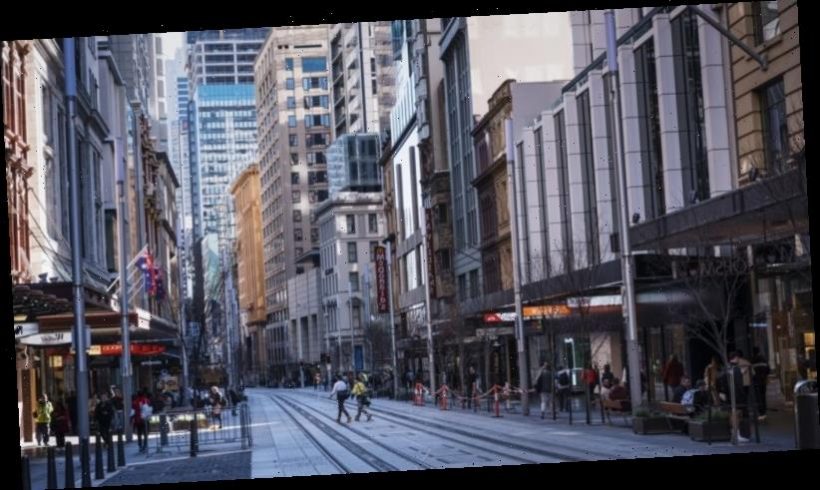Sydneysiders have been fleeing for regional parts of NSW, Queensland and even Canberra, using the coronavirus pandemic to look for work and affordable housing outside the nation’s most expensive city.
During the September quarter a net 7782 people left the Greater Sydney region, three in five of them moving to a regional part of NSW, data from the Australian Bureau of Statistics show.
Sydney CBD was relatively empty during lockdowns.Credit:James Brickwood
Melbourne lost a net 7445 residents, which along with Sydney’s figures resulted in capital cities nationally losing 11,200 people to regional areas, the biggest quarterly movement out of metropolitan Australian on record.
Migration out of the nation’s two largest cities has almost doubled since the September quarter last year, before the advent of the pandemic. The pandemic has also slowed the natural movement of Australians around the country, with total internal migration down almost 8 per cent over the past year.
ANU demographer and social researcher Liz Allen said households have realised more can be done remotely beyond the limits of the nation’s capitals, including working from home.
“But with a greater push for workers to return to physical offices, the opportunities for living in regional areas will be constrained,“she said.
Another reason for the move to the bush is workers who have lost income through a reduction in hours, or loss of a job are struggling to get work in the city during lockdowns. “Moving to new opportunities and/or away from restrictions is certainly reflected in the data,” Dr Allen said.
The ABS data shows Sydney’s population age profile is changing due to the pandemic.
The number of 15 to 24 year-olds leaving the city has climbed almost tenfold since the September quarter last year, while there has been a 21 per cent increase in the departures of people aged between 25 and 64.
By contrast, Perth attracted a net 320 people aged between 25 and 44 in the September quarter. The year before, it lost 266.
There has been an improvement in the jobless rate since the height of the coronavirus outbreaks but the recovery is ongoing. Official payroll jobs data shows since March 2020, accommodation and food services roles are down 14.7 per cent and education and training jobs are 13.8 per cent lower.
Jobs worked by 20 to 29-year-olds fell 6.5 per cent since the weekend ending March 14.
“The trend we’re seeing at present is the result of others not moving into the areas where people have left, which would ordinarily happen. I expect this trend of net excess movements away from capital cities will be short-lived,” Dr Allen said.
The major limitation on the regions is “woefully inadequate” infrastructure, she said, with employment, housing and education unable to meet the need of a flood of new residents in the short-term.
“In the absence of any real investments in regional areas, the moment … infections settle we’ll likely have a resumption of pre-COVID internal migration patterns.”
In a sign of the potential long-term economic hit Melbourne will take due to its pandemic lockdown through the second half of last year, new arrivals into the city are down 30 per cent since the September quarter of 2019. By contrast, arrivals to Sydney have dropped by 12 per cent.
University of NSW City Futures Research Centre director Bill Randolph said the number of people leaving Sydney and Melbourne is not significant for cities with populations of about 5 million people, and there are limitations on regional areas’ ability to cater to huge inflows of new residents.
“One is the capacity of the regional areas to soak these people up. There’s only so much housing,” Professor Randolph said, adding many jobs do not allow work-from-home arrangements permanently and amenities can be limited in remote areas.
“COVID has seen people bring forward their plans so it depends how much of this is brought-forward demand from people who were already going to move,” Professor Randolph said. “I suspect it will die down, but there will be a longer-term restructuring process in the cities.”
These changes could include a move to the outer suburbs of cities, or just over the boundary, to allow commuting into the CBD where needed, he said.
CommSec senior economist Ryan Felsman said in a research note there had been a “stampede” from the major cities to the regions, pushing house prices in these areas up by 7.9 per cent over 2020 in the biggest lift in 16 years. By contrast, CoreLogic recorded a 5.6 per cent drop in rents in the prime inner-Sydney market and a 7.8 per cent decline in Melbourne.
“The recovery in inner-city rentals remains highly dependent on employer return-to-work directives, continued virus suppression and the job market recovery,” Mr Felsman said.
Most Viewed in Politics
Source: Read Full Article

